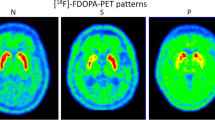Abstract
To clarify cortical lesions responsible for apraxia in corticobasal degeneration (CBD), we reconstructed three-dimensional surface images from single-photon emission computed tomography (SPECT) data withN-isopropyl-p[I-123]-iodoamphetamine in two patients with CBD. Both had limb-kinetic apraxia (LKA) and one also had constructional apraxia (CA). Both showed asymmetrical cortical hypoperfusion in the perirolandic area. The patient with CA had unilateral hypoperfusion in the posterior parietal area. Thus, cortical hypoperfusion in the perirolandic area corresponded to LKA, and that in the posterior parietal area to CA.
Similar content being viewed by others
References
Gibb WRG, Luthert PJ, Marsden CD (1989) Corticobasal degeneration. Brain 112:1171–1192
Riley DE, Lang AE, Lewis A, Resch L, Ashby P, Hornykiewicz O, Black S (1990) Cortical-basal ganglionic degeneration. Neurology 40:1203–1212
Case records of the Massachusetts General Hospital (1985) N Engl J Med 313:739–748
Okuda B, Tachibana H, Kawabata K, Takeda M, Sugita M (1992) Slowly progressive limb-kinetic apraxia with a decrease in unilateral cerebral blood flow. Acta Neurol Scand 86:76–81
Heilman KM, Rothi LJ (1985) Apraxia. In: Heilman KM, Valenstein E (eds) Clinical neuropsychology, 2nd edn. Oxford University Press, New York, p 134
Critchley M (1953) The parietal lobes. Hafner Press, New York, pp 172–202
Tachibana H, Kawabata K, Tomino Y, Sugita M, Fukuchi M (1993) Brain perfusion imaging in Parkinson's disease and Alzheimer's disease demonstrated by three-dimensional surface display with123I-iodoamphetamine. Dementia 4:334–341
Paulus W, Selim M (1990) Corticonigral degeneration with neuronal achromasia and basal neurofibrillary tangles. Acta Neuropathol 81:89–94
Leiguarda R, Lees AJ, Merello M, Starkstein S, Marsden CD (1994) The nature of apraxia in corticobasal degeneration. J Neurol Neurosurg Psychiatry 57:455–459
Benson DF, Cummings JL, Tsai SY (1982) Angular gyrus syndrome simulating Alzheimer's disease. Arch Neurol 39:616–620
Hyvärinen J, Poranen A (1974) Function of the parietal associative area 7 as revealed from cellular discharges in alert monkeys. Brain 97:673–692
Sawle GV, Brooks DJ, Marsden CD, Frackowiak RSJ (1991) Corticobasal degeneration. A unique pattern of regional cortical oxygen hypometabolism and striatal fluorodopa uptake demonstrated by positron emission tomography. Brain 114:541–556
Eidelberg D, Dhawan V, Moeller JR, Sidtis JJ, Ginos JG, Strother SC, Cederbaum J, Greene P, Fahn S, Powers JM, Rottenberg DA (1991) The metabolic landscape of cortico-basal ganglionic degeneration: regional asymmetries studied with positron emission tomography. J Neurol Neurosurg Psychiatry 54:856–862
Rebeiz JJ, Kolodny EH, Richardson EP Jr (1968) Cortico-dentatonigral degeneration with neuronal achromasia. Arch Neurol 18:20–33
Author information
Authors and Affiliations
Rights and permissions
About this article
Cite this article
Okuda, B., Tachibana, H., Takeda, M. et al. Focal cortical hypoperfusion in corticobasal degeneration demonstrated by three-dimensional surface display with123I-IMP: a possible cause of apraxia. Neuroradiology 37, 642–644 (1995). https://doi.org/10.1007/BF00593379
Received:
Accepted:
Issue Date:
DOI: https://doi.org/10.1007/BF00593379




